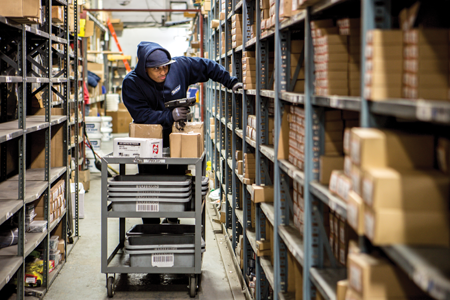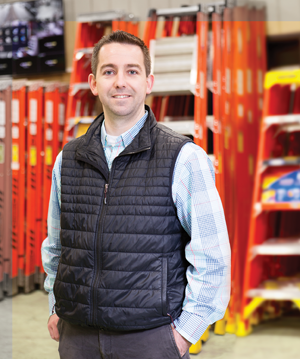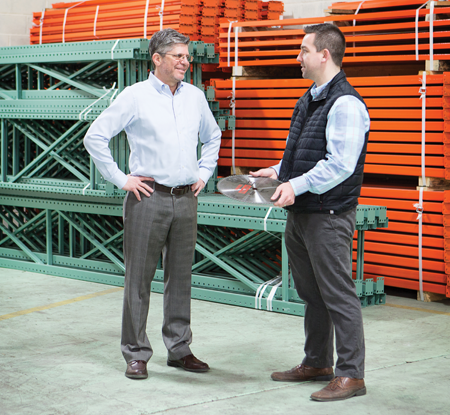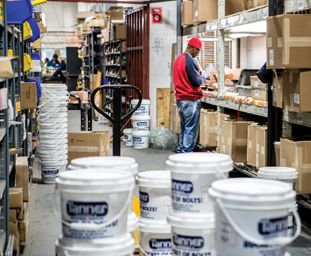Bursting at the Seams in Brooklyn
Paperless picking, high-velocity pick zones and other techniques help Tanner Fasteners and Industrial Supplies maximize efficiency
 |
| Paperless picking has eliminated the need for pickers to make multiple trips to a printer to pick up orders. |
by Rich Vurva
Space is at a premium at Tanner Fasteners and Industrial Supplies in Brooklyn, a distributor of fasteners and contractor supplies. Virtually every shelf in the warehouse is packed from floor to ceiling. Shared space for receiving and packing areas are constantly abuzz with activity, particularly during busy times of the day when UPS and LTL receipts arrive while pickers scramble to meet their deadlines.
“We don’t have a big enough footprint to stage our receiving anywhere else, so we’ve put it down a pick aisle,” explains director of operations and technology, Adam Hart. A receiving person may need to move a staged order out of his way to get to where he needs to put a product, and then the picker may need to move a receiving pallet to access what he’s trying to pick.
Valuable space in a main aisle of the warehouse has to remain clear because that’s where Tanner’s seven delivery vehicles are parked each night. There is not enough dedicated parking space alongside this busy Brooklyn thoroughfare to leave the vehicles outside.
“We’re now doing street loading and unloading and it’s very time consuming,” explains company owner Jeff Tannenbaum. A secondary warehouse building across the street holds overflow inventory, requiring workers to drive a forklift or push a handcart across a busy street multiple times each day. “The logistics of running across a very busy street is not a good long-term solution,” Tannenbaum says.
With anticipated growth in business thanks to a construction boom in New York City at the Trade Center, Penn Station, Hudson Yards and other major construction sites, it became clear that the existing space could not handle additional product flow. The best option was to find a new location.
 |
| Director of operations and technology, Adam Hart, says a move to a new location will more than double storage space. |
By summer, Tanner will have completed a move into a 30,000 square foot facility in another section of Brooklyn that offers nearly one and a half times more space than the current location. One of the biggest advantages of the new building is that it offers four dedicated loading docks.
“Adding loading docks will save us many hours of labor every day,” Tannenbaum says.
To fully appreciate how the new location will help Tanner improve productivity, it helps to understand how the old facility operated for many years.
The Brooklyn Dodgers
The main warehouse and office on Glenwood Road in the current Brooklyn facility also serves as a central distribution center for a second Brooklyn branch and another store in nearby Maspeth, New York. Products move into the building from the same doors where shipments go out, so workers are competing for work space. Some items, like nuts and bolts, need to be repackaged into a Tanner-branded “Bucket of Bolts” before they’re sent to customers, requiring additional space for packing.
Workers continually dodge one another while trying to keep products moving in and out of the facility, and often run up overtime hours in order to get the job done.
Tanner’s five delivery trucks must leave the building between 6:30 and 7 every morning in order to make scheduled deliveries in Manhattan, Queens, Brooklyn, Long Island and the Bronx. It’s critical that the delivery trucks leave on time because traffic into Manhattan is regulated after 11 o’clock in the morning. Two additional vehicles are available for a Quick Ship program that promises same-day delivery for orders placed by 9 a.m.
Recognizing the need to optimize space and processes, Tanner contacted MCA Associates, a management consulting firm focused on operational excellence, for help in redesigning the facility and also in examining the entire warehouse operation for improvement opportunities.
“To their credit, the folks at Tanner have been very open to new ideas,” says Howard Coleman, principal with MCA Associates. For example, Coleman suggested that Tanner consider changing the time of day when personnel begin their work day. By starting earlier in the morning, receivers can unpack and stock inventory before pickers arrive to start filling orders for the day. In the future, the company may move to staggered work hours so staff is on hand during the busiest time of the day.
The company currently uses state-of-the-art methodologies to move product more efficiently and plans to implement additional ideas once the move to the new warehouse is complete.
Paperless picking
Since adopting radio frequency technology, Tanner has eliminated paper from the picking process.
“With Prophet 21 we moved to paperless picking, so we’ve implemented the wireless warehouse that allows us to queue up orders, pick tickets and assign them automatically to our pickers,” says Hart.
Orders are pushed out to each picker’s handheld unit, enabling them to pick and stage the order for checking, packing and routing. The picker is prompted to go to a specific location, verify what item they’re picking and then enter the quantity. The picked item is placed into a tote and moved to a consolidation area for packaging and shipping.
 |
| Company owner Jeff Tannenbaum and director of operations and technology Adam Hart stand in front of new racks ready to be assembled in the company’s new headquarters location. |
High-velocity pick zones
Using information pulled from Tanner’s Prophet 21 software system, the company plans to arrange its new warehouse using high-velocity picking zones, based on an analysis of order hits.
“They wrapped their arms around a relatively simple process of doing a ‘hits analysis,’ or Pareto analysis, to determine which products are ordered most frequently,” Coleman says. “Essentially, the entire design of the warehouse is based on how effective we can be in positioning material in the most appropriate place in the warehouse to reduce the number of steps a picker needs to take.”
In a zone concept, multiple people will pick a single order. Instead of one picker walking throughout the warehouse to pick a complete order, individual pickers are assigned specific zones and pick only from that zone. When picking only from one area, over time, the picker knows where everything is located so he’ll make fewer errors.
As items are picked, they’re moved into a consolidation area for staging and shipping.
“We are estimating that 50 to 75 percent of what we pick on an annual basis will be picked from one high-velocity pick zone. One of the big things we hope to gain in efficiency is having the fastest movers grouped together so we can dramatically increase our throughput,” Hart says.
Moving to zone picking will reduce the number of pickers required to fill orders. Those people can then be reassigned to other tasks, such as consolidating and assembling orders and shipping and loading.
“Instead of having one employee walk around the entire warehouse for every order, you might have three picking five orders at a time,” Tannenbaum says.
Products within the high-velocity zone will be grouped so that pickers will find most-often picked items on shelves between knee level and shoulder height, reducing the amount of movement required to pick an order.
 |
| A new warehouse with zone picking and more space will eliminate the clutter that has created headaches in the company’s current location. |
Narrow aisle design
The new facility also will take advantage of narrow aisle storage. Placed closer together than typical racks that required about 12 feet of space for forklifts to back in and out, narrow aisle storage requires only about 7 feet of space for newer narrow aisle forklifts to operate. The design means that an area that typically could hold about seven storage racks can hold 10 racks, boosting storage space by up to 30 percent.
The new warehouse will also utilize conveyor systems to move product from where it’s picked to the shipping area. The conveyor system will dramatically reduce the amount of steps that pickers need to take to get orders ready for shipment.
Success metrics
Tanner uses several metrics to measure effectiveness, including picks per man hour and cost per pick. Hart hopes that the cost-per-line-item picked should decrease by up to 25 percent when the new warehouse and the zone picking process are fully implemented. Decreasing the amount of time it takes to pick an order generates an overall cost savings.
“For the most part, distributors are still using a lot of old metrics, such as the number of lines shipped and how many orders are shipped on time,” explains Coleman. He suggests that those metrics are useful, but don’t consider cost.
“In a distribution environment, you have to look at cost because if you don’t, you have no real basis for deciding whether there’s any need for improvement. It’s always nice to claim how accurate we are or what percent of our orders shipped on time. Obviously we want to maximize those metrics, but the bottom line is, how much does it cost us to do that? How will future cost avoidance opportunities be impacted?” he says.
This article originally appeared in the May/June 2017 issue of Industrial Supply magazine. Copyright 2017, Direct Business Media.











